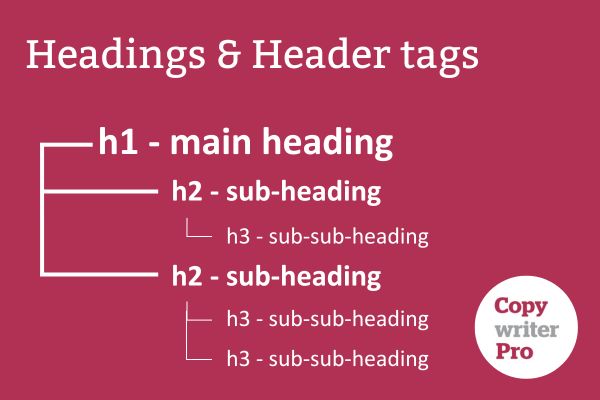Headings that hook - how to structure copy for maximum impact

You want your copy to be read, understood, and acted on? Yep - I guessed as much. Then you need a well-thought-out heading structure.
Great copy doesn’t just rely on words—it relies on structure. Headings and sub-headings are the scaffolding that hold your content together, making it clearer, more engaging, and easier to follow.
Without them, readers face a daunting wall of text. And let’s be honest—no one has time for that.
Why do headings matter?
Headings and sub-headings are key to successful business writing. They make copy -
- Easier to read – Breaking up long text into manageable chunks.
- More scannable – Many readers skim before deciding whether to read in full.
- SEO-friendly – Search engines use headings to understand content.
- More persuasive – A strong heading can grab attention and guide readers through your message.
A well-crafted heading structure pulls readers through the page, keeping them engaged. Think of your audience as busy and easily distracted. At any moment, they could click away—unless you give them a reason to stay.
Effective headings will -
- Keep your readers focused.
- Entice them to stick around and explore further…
…until they reach the end of the funnel and take action. - Without headings, you risk losing potential customers before they even get to the good stuff.
Using a clear headings hierarchy
A good heading structure creates a logical flow, making content more readable for both humans and search engines.
Use heading tags (H1, H2, H3, etc.) to create a structured hierarchy.
H1 – The main title – This is the biggest, boldest message. Every page or article should have just one H1, as it tells both readers and search engines what the page is about.
H2 – Key sections – These divide your content into major themes or points.
H3 – Supporting details – These provide further breakdowns within each H2 section.
Why this matters for SEO
Google loves a well-structured page. By organising your headings into a clear hierarchy—starting with a single H1, followed by H2 sub-headings, with H3s (and sometimes H4s) nested within them—you’re making it easier for search engines to understand the flow of your content.
In short, a logical journey through your page helps both your readers and your rankings.
How to write effective headings
Your headings should -
- Be clear, not clever – Avoid vague or overly creative headings. Readers should instantly know what to expect next.
- Use power words – Words like “proven,” “essential,” or “quick” add impact.
- Be benefit-led – Show the reader why they should keep reading.
- Short* – Aim for six words or fewer where possible.
- Headings should grab attention, provide clarity, and guide readers effortlessly through your content. If they’re too abstract, wordy, or misleading, they’ll do the opposite.
*There are exceptions where long headings can be effective.
Have you seen the Woody Allen Movie - Everything You Wanted To Know About Sex But Were Afraid To Ask?
Loved it! But I was a teenager ... and this was 1972!
How to format sub-headings
Sub-headings should -
- Expand on the main heading while staying concise.
- Guide the reader naturally from one section to the next.
- (Generally) Use sentence case—this means only capitalising the first letter of the first word for a clean look.
- Some brands prefer title case, where the first letter of each key word is capitalised. This is more common in the U.S., but consistency is what really matters.
Pick a style and stick to it across all your content.
Common mistakes to avoid
Even the best copywriters sometimes get headings wrong.
Avoid these common pitfalls -
- Too many H levels – Stick to H1, H2, and H3 unless absolutely necessary. Overcomplicating things can make your content harder to follow.
- Overly long headings – Keep them punchy and to the point.
- Inconsistent formatting – Make sure all headings follow the same style for a polished look.
Human vs AI - Why you win at writing headings
AI tools can churn out headings at speed, but they often sound generic or lack emotional appeal. You, however, a proper human can do so much better - you can -
1. Adapt your tone to the audience
AI tends to generate neutral, one-size-fits-all headings, whereas a human writer can tailor them to the audience’s needs, preferences, and emotions.
Example -
AI-generated - Ways to improve Customer Service - generic and lacks engagement.
Human-written - Want happier customers? Try these proven service hacks - speaks directly to the reader and builds curiosity.
A human writer understands the brand voice, audience expectations, and context—things AI struggles with.
2. Add subtle persuasion
AI-generated headings often lack the persuasive touch needed to guide readers toward action. A human writer knows how to craft headlines that influence behaviour.
Example -
AI-generated - 10 Benefits of regular exercise - factual but bland
Human-written -10 reasons to start exercising today (you’ll feel the difference instantly!) - adds urgency and a clear benefit.
Humans can weave in psychology, storytelling, and emotion—essential elements of persuasive copy.
3. Make headings feel natural, not robotic
AI-generated headings can sound stiff, repetitive, or awkwardly structured.
Humans instinctively know how to make them flow naturally.
Example -
AI-generated - How To Create A Website That Works For You - slightly clunky and vague.
Human-written - Build a website that actually gets results - simpler, smoother, and more compelling.
Natural-sounding headings are more engaging, making them more likely to pull readers through the content.
Final headings tip
Write your headings first.
They set the direction for your content, keep your writing focused, and ensure your structure makes sense before you dive into the details.
A strong heading hierarchy is the difference between copy that flows and copy that flops.
Get it right, and you’ll keep your readers hooked from start to finish.



